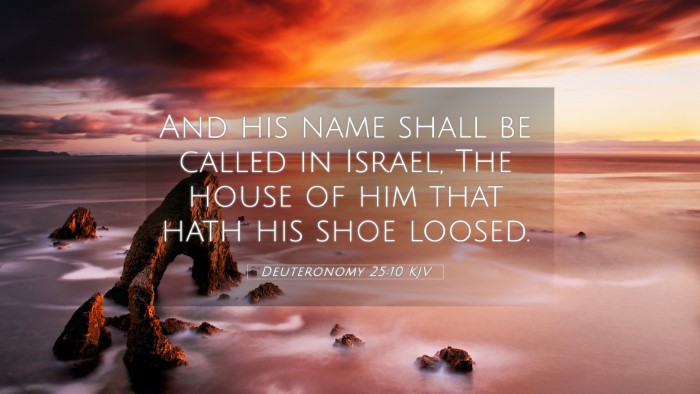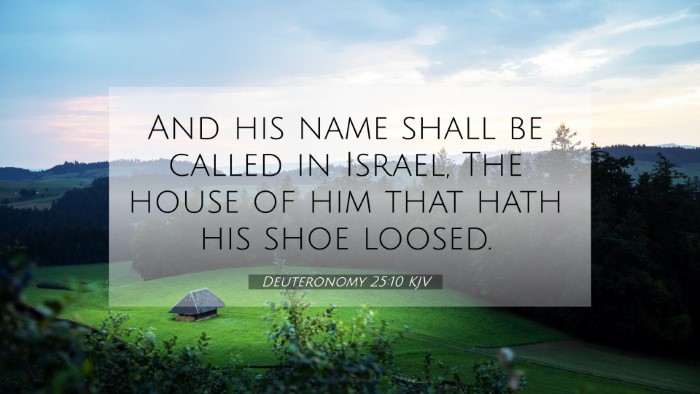Understanding Deuteronomy 25:10
Deuteronomy 25:10 states: "And his name shall be called in Israel, The house of him that hath his shoe loosed." This verse addresses an unusual practice concerning levirate marriage, where a man is required to marry the widow of his deceased brother if he died childless, ensuring the continuation of the family name.
Summary of Insights
This verse serves as a reminder of the importance of family lineage in ancient Israelite culture and the practices that guided the preservation of one's name and inheritance. Several commentaries provide deeper insights into its meanings:
- Matthew Henry: Emphasizes the significance of the act in maintaining the family name and estate, and how the custom was intended to prevent the erasure of one’s legacy. He discusses the social implications of this practice.
- Albert Barnes: Notes the cultural context that underlines the legal obligations within families. He highlights that the loosing of the shoe symbolizes the man’s renouncement of his duty to uphold his brother's family name, thus portraying a sense of shame attached to the act.
- Adam Clarke: Provides a commentary on the broader implications of the law concerning marriage and family. Clarke points out that this law was not simply about the individual but about ensuring the continuation of God's covenant people.
Insights from Public Domain Commentaries
The interpretations provided by these commentators reveal the complexity of biblical laws and the ways they are interwoven with the cultural norms of the time:
Emphasis on Lineage
The act of removing a shoe is a profound symbol in Israelite tradition. It reflects not just a personal loss, but a corporate responsibility to a family lineage. Such insights challenge readers to think about how similar themes of family and legacy play a role in contemporary faith practices.
The Cultural Significance
These commentators bring to light how understanding the culture of ancient Israel enhances comprehension of scriptural texts. It demonstrates how deeply social norms influence biblical laws and how they reflect God’s plan for His people.
Cross-References and Biblical Connections
This verse relates to several other scriptures that discuss themes of marriage, familial duty, and societal obligations. Some notable cross-references include:
- Genesis 38:8-10: The story of Judah and Tamar, illustrating the importance of levirate marriage.
- Ruth 4:7-10: The transaction involving Boaz and Ruth highlights the redemption and preservation of family name.
- Hebrews 7:14: Reference to the lineage of Jesus showing the significance of family in redemption.
- Matthew 22:24-30: Jesus reframes the levirate law in the context of resurrection, indicating its continued relevance.
- Mark 10:6-9: Jesus’s teaching on marriage, alluding to the union's sanctity.
- 1 Corinthians 15:12-22: Discusses resurrection in the context of familial priority.
- Galatians 3:29: Connection of believers to the family of Abraham through faith.
Thematic Connections in Scripture
This verse and its cross-references prompt a meaningful exploration into the following themes:
- Family in Faith: How familial responsibilities intertwine with spiritual obligations.
- Legacy of Faith: The importance of preserving one’s spiritual heritage through generations.
- Redemption: Both in human relationships and through Christ as the redeemer of humanity.
Exploring Cross-Referencing Methods
For those looking to explore the depths of biblical teachings, utilizing cross-reference tools can greatly enhance one's study:
- Bible Concordance: A helpful resource for locating specific verses and understanding their connections.
- Cross-Reference Bible Study: Engaging with various scriptures to draw parallels and contrasts.
- Bible Chain References: Linking scriptures through thematic elements to see a broader picture.
Conclusion
Understanding Deuteronomy 25:10 through the lens of public domain commentaries reveals rich layers of meaning within its text. By engaging with thematic connections and utilizing tools for cross-referencing, readers can gain a more profound understanding of how ancient practices inform modern faith lives. This allows one to embrace the interconnectedness of scripture and the living legacy it represents.


